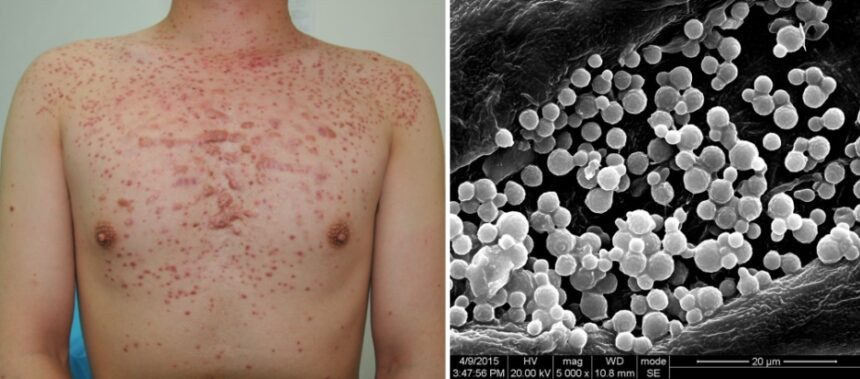Dandruff Malassezia is more than just an occasional flake on your shoulders; it can be a persistent annoyance that impacts your confidence.
If you’ve ever noticed those stubborn white particles appearing regularly, you might be dealing with malassezia-related dandruff.
This type of dandruff stems from a naturally occurring fungus called Malassezia, which thrives in oily environments and can lead to irritation and inflammation on the scalp.
Navigating through the world of dandruff treatments can feel overwhelming, especially when trying to pinpoint what exactly works for you.
Understanding its root causes and symptoms is crucial in managing this condition effectively.
Whether you’re looking for medical solutions or natural remedies, there’s hope for achieving a flake-free scalp.
Let’s dive into the details about malassezia and equip ourselves with strategies to tackle this pesky problem head-on!
Understanding Malassezia and Dandruff
Malassezia is a genus of yeast that naturally resides on our skin, particularly in areas rich in sebaceous (oil) glands. While it plays a role in maintaining healthy skin flora, an overgrowth can lead to issues like dandruff.
When Malassezia levels spike, it breaks down the natural oils on your scalp. This process releases fatty acids that irritate the skin and trigger inflammation. The result? Flaking and itching—classic signs of dandruff.
Not everyone with Malassezia will experience dandruff. Genetics, immune response, and environmental factors all contribute to how our bodies react to this fungus. Stress or weather changes can exacerbate symptoms too.
Understanding the relationship between malassezia and dandruff is essential for effective management strategies. By recognizing this connection, you’re one step closer to reclaiming a healthier scalp free from those annoying flakes!
Causes of Malassezia-Related Dandruff
Malassezia-related dandruff primarily stems from an overgrowth of the Malassezia yeast, which naturally inhabits the scalp. Several factors can contribute to this imbalance.
Hormonal changes often play a significant role. Fluctuations during puberty, pregnancy, or hormonal therapies can trigger excess oil production, creating a perfect environment for Malassezia to thrive.
Environmental factors also influence dandruff severity. Humidity and sudden temperature shifts may lead to increased skin oiliness or dryness, both promoting yeast proliferation.
Dietary habits are crucial too. A lack of essential nutrients like zinc and omega-3 fatty acids can compromise skin health, potentially exacerbating dandruff issues.
Stress is another player in this scenario. High stress levels might weaken your immune response, allowing Malassezia to flourish unchecked on your scalp. Addressing these root causes is key for effective management of malassezia-related dandruff.
Identifying Symptoms of Malassezia-Related Dandruff
Malassezia-related dandruff can manifest in several distinct ways. The most obvious symptom is the presence of white or yellowish flakes on the scalp and shoulders. These flakes often become more noticeable after scratching.
Itching is another common complaint. This irritation may vary from mild to severe, leading to discomfort throughout the day.
In some cases, redness and inflammation might accompany these symptoms. If you notice patches of irritated skin on your scalp, it could signal a malassezia overgrowth.
Some individuals experience oily scales that cling tightly to the hair follicles, making them difficult to remove during regular washing.
Being aware of these signs helps in seeking appropriate treatment early on, preventing further complications down the road.
Treatment Options for Malassezia-Related Dandruff
When dealing with malassezia-related dandruff, treatment options abound. Antifungal shampoos are often the first line of defense. Look for ingredients like zinc pyrithione, ketoconazole, or selenium sulfide.
These active components help to reduce the presence of Malassezia on your scalp. Regular application can significantly diminish flakiness and irritation.
Over-the-counter treatments might not always work for everyone. In such cases, prescription-strength formulas could be necessary. A dermatologist can recommend potent solutions tailored to individual needs.
In addition to medicated shampoos, consider incorporating topical corticosteroids if inflammation persists. These creams or lotions can soothe your scalp and alleviate itching effectively.
It’s essential to remain consistent with any chosen treatment plan. Results may take time but sticking with it will yield better outcomes in managing those pesky flakes.
Natural Remedies for Managing Malassezia-Related Dandruff
Natural remedies can be a gentle way to manage malassezia-related dandruff. Many people find success with tea tree oil, known for its antifungal properties. Diluting it in a carrier oil and massaging onto the scalp may reduce irritation.
Another popular option is apple cider vinegar. Its acidity helps balance scalp pH, potentially inhibiting fungal growth. Mixing equal parts of water and vinegar can create a soothing rinse after shampooing.
Coconut oil is also worth exploring. It moisturizes the scalp while combating dryness, which often exacerbates flaking. Applying warm coconut oil before washing your hair might provide relief.
Herbal-infused oils like neem or rosemary could offer additional benefits as well. These plants carry antimicrobial qualities that help keep malassezia at bay when used regularly on the scalp.
Remember to patch test any new remedy to avoid allergic reactions or irritation before fully integrating it into your routine.
Lifestyle Changes to Prevent Recurrence of Dandruff
Making simple lifestyle changes can significantly reduce the chances of dandruff returning. Start by maintaining a balanced diet rich in vitamins and minerals. Foods high in omega-3 fatty acids, like fish and walnuts, can improve scalp health.
Stay hydrated throughout the day to keep your skin moisturized. Dehydration often leads to dryness that exacerbates flaking.
Stress management is crucial as well. Engage in activities you enjoy—whether it’s yoga, meditation, or just spending time outdoors—which can help lower stress levels and support overall skin health.
Regularly washing your hair with appropriate shampoos helps maintain cleanliness without irritating the scalp. Avoid using excessive heat when styling; opt for cooler settings instead.
Consider adjusting your hair care products. Look for those free from harsh chemicals that might trigger flare-ups or irritation on sensitive scalps.
Conclusion
Managing malassezia-related dandruff can feel overwhelming, but it’s important to remember that effective strategies exist. By understanding the underlying causes and symptoms of this condition, you empower yourself to make informed decisions about treatment options.
Exploring both medical treatments and natural remedies provides a well-rounded approach. Lifestyle changes play a crucial role in prevention as well; maintaining scalp health through proper hygiene and diet helps reduce flare-ups.
Stay proactive in your care regimen, and don’t hesitate to consult with a healthcare professional if symptoms persist or worsen. With patience and commitment, relief from malassezia-related dandruff is achievable, allowing you to enjoy healthier hair and scalp once again.





